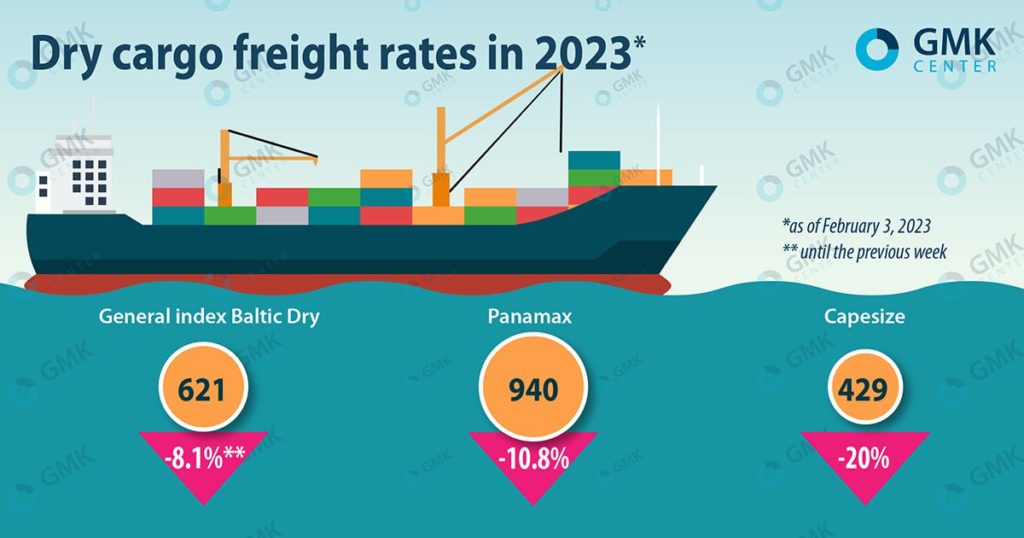Τhe beginning of 2023 was marked by a drop in iron ore shipments
Indexes. At the end of last week, on February 3, 2023, the general index of Baltic Dry which takes into account rates for Capesize, Panamax and Supramax class vessels, fell to 621, the lowest level since mid-June 2020, informs Hellenic Shipping News. Over the week, it fell by 8.1%, falling for the fifth week in a row.
Panamax Index, which tracks cargoes of coal and grain from 60 thousand tons to 70 thousand tons, fell to 940 on February 3, by 10.8% compared with the previous week. This is the lowest rate since June 15, 2020. The average daily earnings for vessels of this class fell by $438 – to $8.45 thousand.
Capesize index, tracking 150,000 tons of iron ore and coal dropped to 429 on February 3 – by 20% for the week. This is at least five months. The average daily earnings for ships of this class decreased by $127 – to $3.56 thousand.

Trend. The beginning of 2023 was difficult for the dry cargo sector. The first three weeks of the year, according to Hellenic Shipping News, featured a 13.1% drop in iron ore shipments compared to the same period in 2022. Such volumes were the lowest since at least 2019, worsening conditions for Capesize class vessels.
The weakness of the market was due to several reasons – the traditional drop in demand due to the celebration in Asia of the New Year according to the lunar calendar; heavy rains in Brazil, which led to the suspension of mining, a drop in iron ore supplies from the country by 34.2% y/y for the first three weeks of 2023. At the same time, the export of iron ore from Australia also decreased during this period, and could not compensate for the impact of these factors. To restore freight rates, higher demand for transportation is required.
At the end of January, despite low rates, market expectations for 2023 remained positive. Capesize’s charter agreements for the current year have rebounded by almost 30% after China eased its zero-tolerance policy on COVID-19 in early December.
According to analysts, the Capesize market will be heavily dependent on the recovery of China’s real estate sector. However, despite some positive factors, consumer sentiment remains weak so far, which may delay the process until the second half of 2023. The rise in iron ore prices, which has been observed since November 2022, could indicate a resumption of demand in China. However, Chinese market regulators have repeatedly issued a warning about excessive speculation.
Forecasts. As representatives of the ship broker Simpson Spence Young (SSY) noted, in 2023 the maritime transport market will be affected by the war in Ukraine, the consequences of the pandemic, which are still correcting global supply chains, and the decarbonization of the shipping business. SSY expects that this year the sea trade in dry bulk cargoes will return to growth, however, its pace, in particular, will depend on the situation in the world steel sector, restrictions on grain supplies and interruptions in other cargoes.
World Grain Edition notes, that during four years, starting from 2018, the world’s dry cargo fleet has increased by 15%, while the volume of cargo transportation has increased by only 2.9%. Accordingly, there was an imbalance between supply and demand. However, port congestion caused by disruptions to supply chains due to COVID helped offset this imbalance. Vessels were idle in ports, reducing the available capacity for chartering and contributing to increased revenues for shipowners and increased freight and charter costs for shippers. A decrease in port congestion may lead to a drop in the cost of freight and charter, and this process has already begun. If port congestion eases during 2023, as expected, and China does relax its coronavirus policy, bulk cargo rates could fall.
According to Maritime Strategies International (MSI), dry bulk volumes will increase by only 1.6% in 2023. As Plamen Natkoff, deputy director of bulk goods and freight at MSI, noticed, maritime trade is unlikely to grow in the first months of the year. However, he gave a positive outlook for the second half of the year for iron ore (its flows are projected to increase by 25-30 million tons during 2023) and small bulk shipments, in particular steel and related materials.
As GMK Center reported earlier, Ukrainian seaports reduced cargo turnover by 61.4% compared to 2021 – to 59 million tons. Export transshipment of cargo by port operators decreased by 59.5% y/y – to 47.8 million tons, and import transshipment – by 74.2%, to 6.2 million tons.
Source: https://gmk.center/

13 thoughts on “Dry bulk rates have been falling since the beginning of 2023”